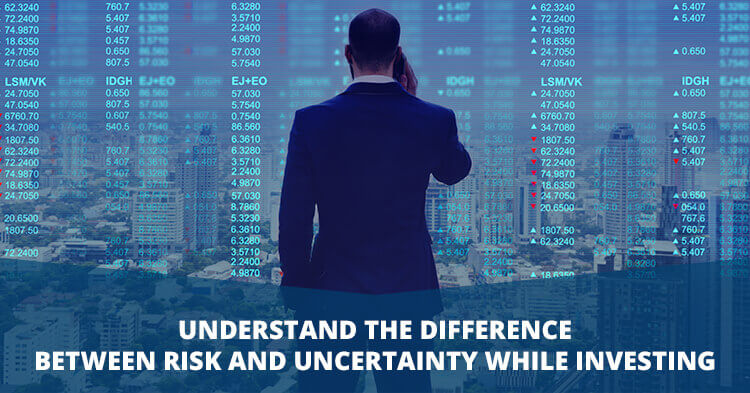
If you have seen investors getting confused between risk and uncertainty then they are not
the only ones. Most people are unable to appreciate the difference between risk and
uncertainty. When you invest in the markets or in any other asset class, there is an element
of risk and also an element of uncertainty. In many ways, you can say that uncertainty is a
very extreme form of risk. You can predict risk based on a mathematical formula and set the
limits. In case of uncertainty it is hard to set limits. That is why uncertainty cannot be
managed; it can only be insured against.
Risk has a negative connotation and a positive connotation to it. For example, stock markets
hate risk and any stock with a higher degree of risk gets a lower P/E valuation. What is the
positive connotation of risk? Remember, all your investment decisions are risk-return trade-
offs. To earn higher returns, you need to take higher risks. However, higher risk, by itself,
does not guarantee you higher returns. How do we define risk? Risk is the potential for loss.
Here loss is defined a little more broadly than your monetary loss or the impact on the
bottom-line. Risk is the probability of a bad thing happening or a good thing not happening.
If you expect a company to make profit and it makes a loss then it is a risk. At the same time,
if you expect the profit of a company to grow by 20% and it actually grows by only 12%; that
is also a risk. That means; risk is always with reference to expectations.
From the financial markets point of view, risk is that which really matters since it can be
measured; understood and managed. Financial markets classify risk into two categories viz.
systematic risk and unsystematic risk. Systematic risk or macro risk is the market level risk
that impacts all businesses. Systematic risk is measured by the Beta of the stock. Then there
are unsystematic risks that are specific to a company or a sector. Issues that are specific to a
company or industry is unsystematic risk. In this case, as an investor you can reduce such
risks by diversifying your portfolio away from such stocks.
Uncertainty is the absence of certainty; now that sounds a little too simplistic! The key issue
here is that since the event is uncertain, even the outcomes are uncertain. Thus it is very
difficult to define uncertainty or to measure it since you are not sure of the outcomes. A
serious illness in the family, an earthquake in your city, a major fire; are all examples of
uncertainty. You cannot measure for that and since you cannot measure, you can either
quantify or plan for it. Focus on the use of the word possible with respect to uncertainty.
Now the basic difference between risk and uncertainty! Risk is probably and uncertainty is
possible. When it comes to risk, we use the word probable because you can assign
quantitative probabilities to outcomes based on past experience. In case of uncertainty,
since outcomes and events are uncertainty, you cannot measure uncertainty.
It is said that risk is measurable uncertainty and uncertainty is the risk that cannot be
measured. Anything that can be measured can be managed and anything that cannot be
measured obviously cannot be managed. Let us look at 3 points of difference between risk
and uncertainty.
Understanding the difference between risk and uncertainty is at the core of investing.
Remember, investing in the markets and financial planning are largely about managing your
risk. Insurance helps you to manage the uncertainty.
Published on: Jan 2, 2019, 4:25 PM IST
We're Live on WhatsApp! Join our channel for market insights & updates